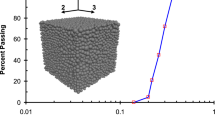Abstract
Recently, quasimolecular dynamics has been successfully used to simulate the deformation characteristics of actual size solid materials. In quasimolecular dynamics, which is an attempt to bridge the gap between atomistic and continuum simulations, molecules are aggregated into large units, called quasimolecules, to evaluate large scale material behavior. In this paper, a 2-dimensional numerical simulation using quasimolecular dynamics has been performed to investigate laminar composite material fracture and crack propagation behavior in the uniform bending of laminar composite materials. We verified that laminar composite materials deform quite differently from the case of homogeneous materials under bending deformation.
Similar content being viewed by others
References
DeCelis, B., Argon, A. S., and Yip, S., 1983. “Molecular Dynamics Simulation of Crack Tip Processes in Alpha-Iron and Copper,”J. Appl. Phys., Vol. 54, pp. 4864–4878.
Kitagawa, H., Nakatani, A., and Shibutani, Y., 1993, “Study on Computational Modelling for Materials with Crystalline Structure,”Trans. JSME, Vol. A59, pp. 1834–1841 (in Japan)
Greenspan, D., 1986, “Quasi-Molecular. Particle Modeling of Crack Generation and Fracture,”Computers and Structures, Vol. 22, pp. 1055–1061.
Greenspan, D., 1989, “Supercomputer Simulation of Cracks and Fractures by Quasimolecular Dynamics,”J. Phys. Chem. Solids, Vol. 50, pp. 1245–1249.
Kim, Y. and Park, J., 1997, “Analysis of Metallic Solid Fracture by Quasimolecular Dynamic,”Advanced Method in Materials Processing Defects, M. Predeleanu and G. Gilormini ed., Elsevier, pp. 457–458.
Maiti, D. K. and Sinha, P. K., 1996, “Bending, Free Vibration and Impact Response of Thick Laminated Composite Plates,”Comp. Struct., Vol 59, No 1, pp. 115–129.
Suga, M., Honda, M., Nagae, M., Seki, M., Izawa, T., and Kaneko, Y., 1989, “The Newly Developed Stainless Clad Steel Plates for the Hull Structure of Chemical Tankers,”NKK Tech. Review, Vol. 55, pp. 55–72.
Triantafyllidis, N., Needleman, A., and Tvergaard, V., 1982, “On the Development of Shear Bands in Pure Bending,”Int. J. Solids Structures, Vol. 18, No. 2, pp. 121–138.
Yoshida, F., Okada, T., Itoh, M., Harada, Y., and Ohmor, M., 1998, “Bendability of Aluminium and Steel Clad Chromium Plates,”Metals and Materials, Vol. 4, No. 3, pp. 426–431.
Ashurst, W. T. and Hoover, W. G., 1976, “Microscopic Fracture Studies in the Two-Dimensional Trianglar Lattice,”Physical Review, B14, pp. 1465–1473.
Kim, Y. and Park, J., 1998, “Molecular Dynamics Simulation for Micro Fracture Behavior of Material,”KSME Int. J., Vol. 12, No. 3, pp. 388–395.
Lee, D., 1993, Mechanics and Manufacturing Process of Composite Material, Sung-an-dang press, Korea, Seoul (in Korea)
Author information
Authors and Affiliations
Rights and permissions
About this article
Cite this article
Kim, Y., park, J. Analysis of bending fracture propagation of laminar composite materials using quasi-molecular dynamics. KSME International Journal 12, 1026–1033 (1998). https://doi.org/10.1007/BF02942576
Received:
Issue Date:
DOI: https://doi.org/10.1007/BF02942576




